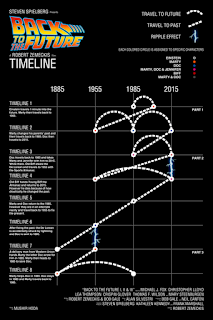In the last blog post on Back to the Future, after my CTN road trip detour, I described how I would first find the beats, then identify them as to their function. This is necessary in preparation for mapping the complete story weave of the story. Here are the beats for ACT 1 of Back to the Future and how they function in the story. I created this list of functions as I needed them to understand their role in the story and how they drive it along.
1. INTRODUCE WORLD OF PROBLEM AND DOC (Indirectly)
Long camera pan reveals wealth of clues about Doc and themes of the movie.
In his garage laboratory we see a large collection of clocks, photos of scientists, inventions and indications that he hasn’t been there in a while.
Robotic can opener opens dog food and empties into bowl marked Einstein.
TRIVIA HOMAGE: Look for Harold Lloyld hanging from the clock.
2. INTRODUCE PROBLEM: Stolen Plutonium
A news woman announces the theft of plutonium.
3. INTRODUCE UNKNOWN KID and Einstein
Marty McFly calls out, He places a set of keys under doormat, then drops it down. Marty enters the garage, calling out for Doc and whistling for Einstein.
He comments on the mess the place is in.
4. PAYOFF INFO: Stolen Plutonium, NARRATIVE QUESTION: Why?
Marty puts down his skateboard, it rolls on floor to hit a box of Plutonium.
5. ACTION (MISDIRECT: Think turning on time machine)
He turns dials on machinery, turning all the settings to maximum.
5. ACTION
Marty plugs his electric guitar into a huge amplifier and plucks a string.
6. COMEDY REACTION
The amplifier blows up, the impact throwing Marty back.
7. INTRODUCE MARTY
Marty lifts up his sunglasses and we finally get to see his whole face.
8. INSTRUCTIONS FOR ACTION
Marty answers Doc on phone who says to meet him at Mall at 1:15 a.m..
9. SETUP TIME
The clocks all start chiming, Doc’s elated, his experiment worked, his clocks are slow.
10. DISCOVERY (MISDIRECT) Marty is shocked at the news. We think he’s excited about TIME TRAVEL but instead, it means he's late for school. Marty skateboards to school.
11. INTRODUCE: His girlfriend Jennifer warns the principal is gunning for him.
12. INTRODUCE: Principle Strickland warns Marty to stay away from Doc, he’s dangerous. (ESTABLISH DOC’S PERSONALITY)
13. FORESHADOW: Strickland tells Marty he’s a slacker, just like his father.
"No McFly ever amounted to anything in the history of Hill Valley”.
Marty replies, “Yeah well, history is gonna change."
14. SETUP SKILL: Marty and his band get up on stage to audition for school.
A judge (Huey Lewis, in a cameo) cuts them off. They’re too loud.
15. RELATIONSHIP POSITIVE: After school, Marty and Jennifer are walking through the Courthouse Square. Marty tells Jennifer his band got kicked off stage. He doubts he'll ever succeed in music. Jennifer tries to reassure him, she believes in him and gives him a pep talk.
16. RELATIONSHIP NEGATIVE:
Marty expresses his fear of rejection if he sends in his music.
17. SEGWAY:
Marty admires a new Toyota. It would be great for their camping trip.
18. FORESHADOW RELATIONSHIP: Jennifer asks if Marty's mother knows about their plans for the next night. Marty tells her he lied, his mother thinks he's going camping with the guys. Marty says how his mother was probably born a nun. Jennifer defends her.
19. RELATIONSHIP PROGRESS:
Just as they’re about to kiss, a tin can is shoved in their faces.
20. RELATIONSHIP INTERRUPTION TO PLANT INFORMATION
"Save the clock tower!" a woman exclaims. The clock tower was hit by lightning thirty years ago and hasn't run since. They want to preserve it.
Marty gives her a quarter to go away. She thanks him and hands him a flier.
21. RELATIONSHIP & DRAW ATTENTION TO FLYER TRANSFER TO MARTY: They’re about to kiss again, but a car pulls up honking.
Jennifer's has to leave and scribbles her number on the back of the clock tower flyer with "Love You!!!". She gets into the car. Marty looks at the flyer and smiles.
22. TRANSPORTING:
Marty skateboards hitching on the bumper of a cop car to his house.
23. SETUP RELATIONSHIPS:
Marty sees his father’s wrecked car. Biff his dad’s supervisor, is blaming his dad, George for Biff’s accident. Then he berates him for not typing up his work for him. Biff ridicules Marty as well as he leaves. Also sets up that he knows his mom, Lorraine.
24. MORE SETUP RELATIONSHIPS:
Marty’s brother leaves dinner to work at a burger joint. His sister tells him that Jennifer called twice.
25. MORE IRONIC FORESHADOWING:
Her mom, Lorraine lectures that any girl who calls a boy is inviting trouble.
Lorraine says she was never like that.
26. SETUP EXPOSITION:
Linda asks how she's supposed to meet anyone by waiting.
27. PAYOFF EXPOSITION:
Lorraine tells Linda it will happen like when she met her father, George. Lorraine explains her father hit George with his car after he fell out of a tree.
She asked him to the school dance and when they kissed she knew.
28. ACTION:
Doc tells Marty to get the video camera. A DeLorean rolls out of the van.
Doc emerges from the DeLorean and tells Marty to start recording.
29. ACTION: VIDEOED
Doc puts Einstein in the DeLorean, with a watch, Doc's clock is synched to the exact same time.
Doc pulls out a remote control and sends the DeLorean streaking right towards him and Marty. A bright light flashes and the DeLorean disappears.
Doc cheers, "88 miles per hour”!
30. IRONIC MISDIRECT:
Marty’s shocked thinking Doc disintegrated Einstein.
31. EXPOSITION:
Doc tells Marty he sent Einstein into the future.
32. ACTION:
The DeLorean returnes. Einstein is alive and well, but his watch now one minute late.
33. EXPOSITION & SETUP: TIME TRAVEL EXPLAINED
Doc shows the "flux capacitor", inserted in the DeLorean, which makes time travel possible.
Doc explains in 1955 hitting his head caused a vision of the Flux Capacitor.
It took 40 years to develop it. The time machine is a success and Doc plans to travel through time.
34. ACTION:
Doc absently sets the vehicle's destination time to 1955.
35. EXPOSITON:
When Marty asks what the DeLorean runs on, Doc tells him it needs plutonium to generate a nuclear reaction to create 1.21 gigawatts of power .
Marty asks where he got plutonium. Doc hired terrorists to steal it with the promise of making them a bomb. But instead, Doc delivered a fake bomb.
36. ACTION:
Doc and Marty in radiation suits, load plutonium into the DeLorean.
Marty shoots video.
37: OBSTACLE CONSEQUENCE ACTION:
A van drives into the parking lot and begins shooting at them.
Doc yells, “run”, it’s the terrorists that Doc cheated. The terrorists kill the Doc.
38. ACTION:
Marty tries to hide but the terrorist tries to shoot him. Marty prepares for his end.
39. SURPRISE TWIST:
The terrorist’s rifle jams.
40. MAIN CHARACTER ACTION:
Marty tries to escape in the DeLorean. The time machine begins to activate. And when it reaches 88 mph there’s a flash of blinding light.
This is the end of ACT 1. It also marks our first crossing of the x axis 0 point. It is at this point that Marty has taken significant action towards propelling the story by escaping in the time machine, not realizing that it will take him back in time.
When I look at this list, I'm already overwhelmed. I can't keep it all in my memory. There has to be a better way to see the big picture.
To start, lets' look at the hierarchy of narrative questions raised in ACT 1. We'll focus on the main driving questions of the story and ignore ones that are for comedic purposes, such as the giant guitar amp. Some of these questions are asked directly in the story, while others are implied. Sometimes even the title can ask an implied question. In Back to the Future we want to know who's going to time travel and when will they go to and what will happen?
The reason why these are important is that you are making a pact with your audience that you will answer these questions for them by the end of the story. If you don't, you risk alienating your audience.
First, we want to know who the Doc is, and who the kid is. By delaying the introduction of the Doc, he becomes more mysterious. We also focus on Marty who will be our main character that we identify with. We also want to know who will travel to where with the time machine. This expectation is played with by the suggestion that all of the guitar amp dials could also be read as dials on a time machine. As writers we should know that we, the audience, couldn't have had enough information to go time traveling in the first few pages.
Marty is late for school and is warned about the principle. Can he escape him? He can't. He's warned he'll become like the rest of his family. Will he? The next question asked is will Marty's and Jennifer's relationship develop? Then the woman interrupts their attempted kiss with a request to save the clock tower. Will they save the clock tower?
Marty returns home where we're given a lot of exposition that will guide us later in the story. Marty then videos Doc as he demonstrates the time machine. There's a quick visual question asked, what will the time machine look like? The second quick narrative question is did Einstein get disintegrated? We get the answer almost immediately as he returns demonstrating that the DeLorean time machine works. Then the terrorists come, and we ask will they get away. The answer is no- the Doc is shot. Will Marty get shot too? The gun jams, and Marty gets away then there's the flash of light. Where's he go?
When I say it's a hierarchy of narrative questions, I mean that there are big overreaching questions and then smaller questions that get answered along the way of the bigger questions. I've found a way to map these is to imagine them as a computer programming language where everything must be contained within hierarchical matching brackets.
Let's give it a shot.
{Who's going to time travel?
{When?
{What will happen?
{Who is Doc?
{Who is Marty?
We learn Marty is a school kid who's friends with the Doc.}
{Will Marty evade the principle?
{Is Marty a "slacker"?
{Will Marty and Jennifer's relationship develop?
No. Instead it's an excuse to be given more exposition.}
{Will they save the clock tower? But does it matter?...
We meet Doc the eccentric inventor.}
{Will the time machine work?
After Marty thinks Einstein is disintegrated, the answer is yes.}
{Will the terrorists kill Doc?
Yes, doc gets shot.}
{Will Marty get shot?
No. The gun jams. Marty gets away.}
{Will the DeLorean time travel?
Yes, and it takes Marty and we know that Doc set it to 1955.}
If you follow the narrative questions and their answers, we see that there is one important driving question left and two smaller ones. What will happen to Marty in the past? Will he become a "slacker"? And what will happen with their relationship? Also how does his family fit into this?
There's one more question, will the clock tower be saved but do we care? The first question, what happens to Marty, keeps the audience sticking around to see what's going to happen. The second question we don't really have enough information to care about.
To be continued...































